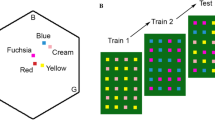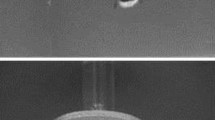Abstract
Unrewarding artificial flowers that trapped approaching bumblebees were used here for the first time to assess the effects of several floral characteristics on floral attractiveness to bumblebees that never obtained food from flowers. Floral size and floral scent had no discernable effect. In a comparison between two colors (white and blue) and two shapes (radial and square), choice proportions for blue radial flowers were significantly greater than chance. Our proposed method is an alternative to prior training, with food associated either with visual or olfactory stimuli, which is unnecessary to obtain floral preferences by free-flying bumblebees exploring potential food sources.



Similar content being viewed by others
References
Asada S, Ono M (1996) Crop pollination by Japanese bumblebees, Bombus spp. (Hymenoptera: Apidae): tomato foraging behaviour and pollination efficiency. Appl Entomol Zool 31:581–586
Blarer A, Keasar T, Shmida A (2002) Possible mechanisms for the formation of flower size preferences by foraging bumblebees. Ethology 108:341–351
Chittka L (1992) The color hexagon—a chromaticity diagram based on photoreceptor excitations as a generalized representation of color opponency. J Comp Physiol A 170:533–543
Chittka L, Kevan PG (2005) Flower colour as advertisement. In: Dafni A, Kevan PG, Husband BC (eds) Practical pollination biology. Enviroquest, Cambridge, pp 157–196
Chittka L, Thomson JD (eds) (2001) Cognitive ecology of pollination. Cambridge Univesity Press, Cambridge
Chittka L, Walker J (2006) Do bees like Van Gogh’s Sunflowers? Opt Laser Technol 38:323–328
Chittka L, Skorupski P, Raine NE (2009) Speed-accuracy tradeoffs in animal decision making. Trends Ecol Evol 24:400–407
Church DL, Plowright CMS (2006) Spatial encoding by bumblebees (Bombus impatiens) of a reward within an artificial array. Anim Cogn 9:131–140
Cnaani J, Thomson JD, Papaj DR (2006) Flower choice and learning in foraging bumblebees: effects of variation in nectar volume and concentration. Ethology 112:278–285
Cresswell JE, Robertston AE (1994) Discrimination by pollen-collecting bumblebees among differentially rewarding flowers of an Alpine wildflower, Campanula rotundifolia (Campanulaceae). Oikos 69:304–308
Dornhaus A, Chittka L (1999) Evolutionary origins of bee dances. Nature 401:38
Dukas R, Ratcliffe JM (eds) (2009) Cognitive ecology II. University of Chicago Press, Chicago
Dyer AG, Whitney HM, Arnold SEJ, Glover BJ, Chittka L (2007) Mutations perturbing petal cell shape and anthocyanin synthesis influence bumblebee perception of Antirrhinum majus flower colour. Arthropod Plant Interact 1:45–55
Galen C (1989) Measuring pollinator-mediated selection on morphometric floral traits: bumblebees and the alpine sky pilot, Polemonium viscosum. Evolution 43:882–890
Galen C, Newport MEA (1987) Bumble bee behavior and selection on flower size in the sky pilot, Polemonium viscosum. Oecologia (Berlin) 74:20–23
Giurfa M, Núñez J, Chittka L, Menzel R (1995) Colour preferences of flower-naïve honeybees. J Comp Physiol A 177:247–259
Gumbert A (2000) Color choices by bumble bees (Bombus terrestris): innate preferences and generalization after learning. Behav Ecol Sociobiol 48:36–43
Heuschen B, Gumbert A, Lunau K (2005) A generalized mimicry system involving angiosperm flower colour, pollen and bumblebees’ innate colour preferences. Plant Syst Evol 252:121–137
Ings TC, Raine NE, Chittka L (2009) A population comparison of the strength and persistence of innate colour preference and learning speed in the bumblebee Bombus terrestris. Behav Ecol Sociobiol 63:1207–1218
Inoue K, Maki M, Masuda M (1995) Different responses of pollinating bees to size variation and sexual phases in flowers of Campanula. Ecol Res 10:267–273
Jakobsen HB, Krisjánsson K, Rohde B, Terkildsen M, Olsen CE (1995) Can social bees be influenced to choose a specific feeding station by adding the scent of the station to the hive air? J Chem Ecol 21:1635–1648
Laloi D, Sandoz JC, Picard-Nizou AL, Marchesi A, Pouvreau A, Taséi JN, Poppy G, Pham-Delègue MH (1999) Olfactory conditioning of the proboscis extension in bumble bees. Entomol Exp Appl 90:123–129
Leadbeater E, Chittka L (2009) Bumble-bees learn the value of social cues through experience. Biol Lett 5:310–312
Lehrer M, Horridge GA, Zhang SW, Gadagkar R (1995) Shape vision in bees: innate preference for flower-like patterns. Phil Trans R Soc Lond B 347:123–137
Lunau K (1990) Colour saturation triggers innate reactions to flower signals: flower dummy experiments with bumblebees. J Comp Physiol A 166:827–834
Lunau K (1991) Innate flower recognition in bumblebees (Bombus terrestris, B. lucorum; Apidae): optical signals from stamens as landing reaction releasers. Ethology 88:203–214
Lunau K (1992) Innate recognition of flowers by bumblebees: orientation of antennae to visual stamen signals. Can J Zool 70:2139–2144
Lunau K, Maier EJ (1995) Innate colour preferences of flower visitors. J Comp Physiol A 177:1–19
Lunau K, Wacht S, Chittka L (1996) Colour choices of naïve bumble bees and their implications for colour perception. J Comp Physiol A 178:477–489
Lunau K, Fieselman G, Heuschen B, van de Loo A (2006) Visual targeting of components of floral colour patterns in flower-naïve bumblebees (Bombus terrestris; Apidae). Naturwissenschaften 93:325–328
Manning A (1956) Some aspects of the foraging behaviour of bumble-bees. Behaviour 9:164–201
Menzel R, Blakers M (1976) Colour receptors in the bee eye—Morphology and spectral sensitivity. J Comp Physiol 108:11–33
Molet M, Chittka L, Raine NE (2009) How floral odours are learned inside the bumblebee (Bombus terrestris) nest. Naturwissenschaften 96:213–219
Munsell AH (1966) Munsell book of color. Munsell Color Company, Baltimore
Plowright CMS, Simonds VM, Butler MA (2006) How bumblebees first find flowers: habituation of visual pattern preferences, spontaneous recovery and dishabituation. Learn Motiv 37:66–78
Plowright CMS, Evans SJ, Chew Leung J, Collin CA (2010). The preference for symmetry in flower-naïve and not-so-naïve bumblebees. Learn Motiv. doi:10.1016/j.lmot.2010.08.009
Pohl M, Lunau K (2007) Modification of the innate antennal reaction at floral guides in experienced bumblebees, Bombus terrestris (Hymenoptera: Apidae). Entomol Gener 29:111–123
Pohl M, Watolla T, Lunau K (2008) Anther-mimicking floral guides exploit a conflict between innate preference and learning in bumblebees (Bombus terrestris). Behav Ecol Sociobiol 63:295–302
Raine NE, Chittka L (2007) The adaptive significance of sensory bias in a foraging context: floral colour preferences in the bumblebee Bombus terrestris. PLoS ONE 2:e556
Rescorla RA (1967) Pavlovian conditioning and its proper control procedures. Psychol Rev 74:71–80
Riabinina O, Hempel de Ibarra N, Phillipides A, Husbands P, Collett TS (2006) Active vision in landmark learning by bumblebees. Perception 35: ECVP Abstract Supplement
Rodríguez I, Gumbert A, Hempel de Ibarra N, Kunze J, Giurfa M (2004) Symmetry is in the eye of the ‘beeholder’: innate preference for bilateral symmetry in flower-naïve bumblebees. Naturwissenschaften 91:374–377
Séguin FR, Plowright CMS (2008) Assessment of pattern preferences by flower-naïve bumblebees. Apidologie 39:215–224
Simonds V, Plowright CMS (2004) How do bumblebees first find flowers? Unlearned approach responses and habituation. Anim Behav 67:379–386
Srinivasan MV, Lehrer M (1984) Temporal acuity of honeybee vision: behavioural studies using moving stimuli. J Comp Physiol A 155:297–312
Stephen WP, Rao S (2005) Unscented color traps for non-Apis bees (Hymenoptera: Apiformes). J Kansas Entomol Soc 78:373–380
Tinbergen N (1951) The study of instinct. Oxford University Press, New York
Toda NRT, Song J, Nieh JC (2009) Bumblebees exhibit the memory spacing effect. Naturwissenschaften 96:1185–1191
Acknowledgements
Special thanks to Bill Stephen for giving us a model artificial flower and to Charles Collin and Ricardo Tabone for their assistance with the colorimetry. Thanks also to Pierre Bertrand for the photographs and Levente Orbán with help with the filming. Jonathan Hudon and Levente Orbán provided constructive criticism on the manuscript. This research was supported by a research grant to C.M.S.P. from the Natural Sciences and Engineering Research Council of Canada and a donation by the Canadian Wildlife Federation.
Author information
Authors and Affiliations
Corresponding author
Rights and permissions
About this article
Cite this article
Hudon, T.M., Plowright, C.M.S. Trapped: Assessing Attractiveness of Potential Food Sources to Bumblebees. J Insect Behav 24, 144–158 (2011). https://doi.org/10.1007/s10905-010-9243-7
Revised:
Accepted:
Published:
Issue Date:
DOI: https://doi.org/10.1007/s10905-010-9243-7




